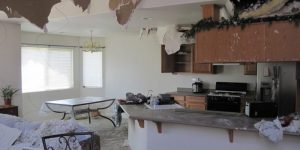Water damage is one of the significant reasons for damage and loss of home. The term ‘water damage’ broadly describes a wide variety of probable losses brought on by the existence of water in a material or system where it can add to damaging processes like de-lamination and decaying of wood and wooden elements, rusting of steel and other material and so on.
Water causes damage by small but consistent deterioration such as water spots or seepage that can mar surfaces or by disastrous scenarios such as breaches and flooding.
Some of the typical water damage irritants in a house can be:
– Bad weather
– Broken pipes or tubes from house devices or drain
– Clogged toilets
– Cracks in the structure
– Leaking roofing systems
– Moisture trapped in between wall surfaces
– Plumbing leaks
As far as insurance coverage is concerned, most damage caused by bad weather is considered flood damage and normally is not covered under house owners insurance. Coverage for bad weather would generally require flood insurance coverage.
Categories of Water Damage
– Category 1 includes “tidy water” or a source or leakage that does not posture any safety or health hazard to humans – e.g. home device malfunctions, broken water lines, tub overruns, etc.
– Category 2 includes “grey water” or a source of water that brings harmful biological pollutants like germs or chemical parts like effluents etc – e.g. unclean or clogged up toilet water closets, seepage from septic systems and so on
– Category 3 includes “black water” and is the most dangerous of all because of its extremely unhygienic nature. This results from water sources affecting home and indoor environments – e.g. sewage backflow, polluted standing or ground surface area water, overruling water from rivers or breached lakes, seawater and so on
. Classification 3 also consists of ‘grey water’ that is not instantly drawn out or removed from the sources of the leakage.
Classes of Water Damage
This is identified by the ‘possible evaporation rate’ based upon the affected surface area and the product. As a primary step to determine remediation, the class of damage needs to be established.
1. Class 1 – ‘slow rate of evaporation’ – when the product absorbs minimum amounts of moisture and just a little area is affected.
2. Class 2 – ‘quick rate of evaporation’ – when water has affected the indoor area of a home – e.g. flooring flooding drenching carpets, cushions, etc.
3. Class 3 – ‘fastest rate of evaporation’ – when water drips or falls from above-impacting ceiling, carpet, cushions, house insulation, walls and so on
4. Class 4 – Specialty Drying Situations – when drying surface areas like concrete floors, wood floorings, plastering and so on with specific low humidity to achieve drying.
Insurance Coverage From Water Damage
In the case of homes, many house insurance coverage does not provide coverage for water damage and water damage repair. Usually, this is an addendum integrated in the policy incurring extra premium payout.
